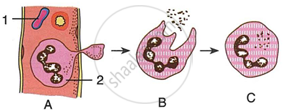Advertisements
Advertisements
Question
The diagrams given below are cross sections of blood vessels:

(i) Identify the blood vessels A, B and C.
(ii) Name the parts labelled 1 to 3.
(iii) Name the type of blood that flows through A.
(iv) Mention one structural difference between A and B.
(v) In which of the above vessels does exchange of gases actually take place?
Solution
(i) A – Artery, B – Vein, C – Blood capillary
(ii)
1 – External layer of connective tissue
2 – Lumen
3 – Middle layer of smooth muscles and elastic fibres
(iii) A (Artery)- Oxygenated blood, B (Vein)- Deoxygenated blood
(iv) An artery has thick muscular walls and a narrow lumen. It does not have any valve. A vein on the other hand has thin muscular walls and a wider lumen. It has valves to prevent backflow of blood.
(v) At the capillary level the actual exchange of gases takes place.
APPEARS IN
RELATED QUESTIONS
Give technical terms for The fluid portion of blood
Given below is certain structure, write the term for the functional activity.
Bone marrow and ………………………………..
Given below is a certain structure, write its chief functional activity.
Neutrophils - ______.
Study the following diagram carefully and then answer the questions that follow:
 |
- Name the cell labelled 1.
- Identify the phenomenon occurring in A.
- Mention two structural differences between 1 and 2.
- Name the process occurring in B and C and state the importance of this process in the human body.
The mineral element essential for the clotting of blood.
Complete the following sentence with appropriate word:
The site of production of W.B.Cs in the embryo is _________
State the Function: Haemoglobin
State the Function: Platelets
Choose the Odd One Out:
